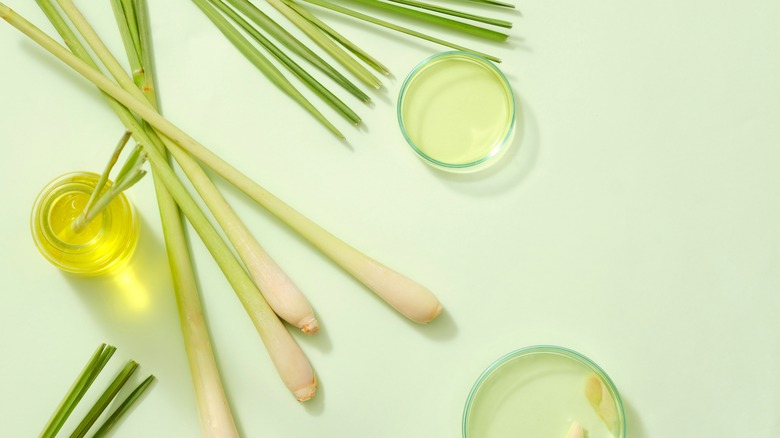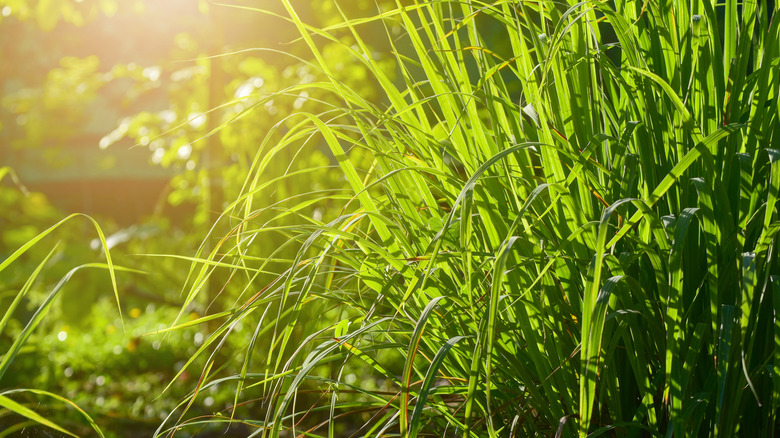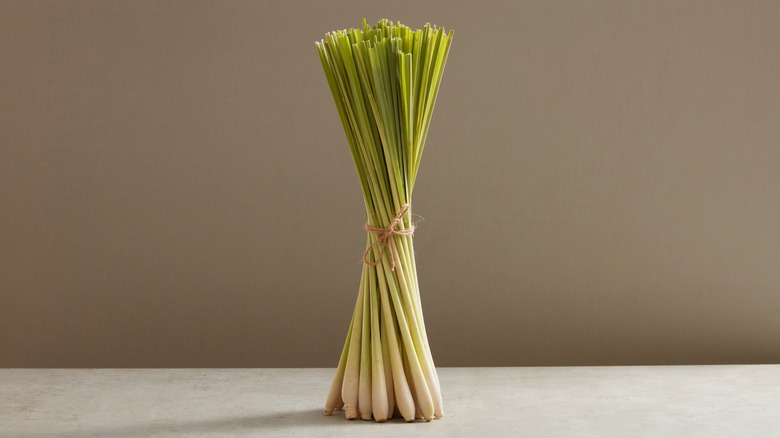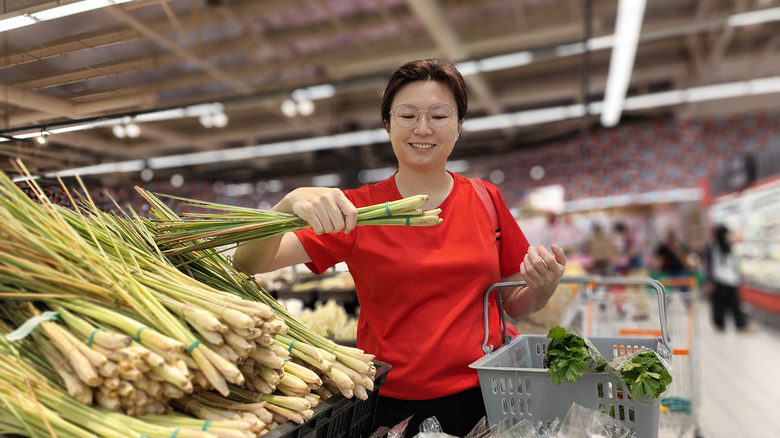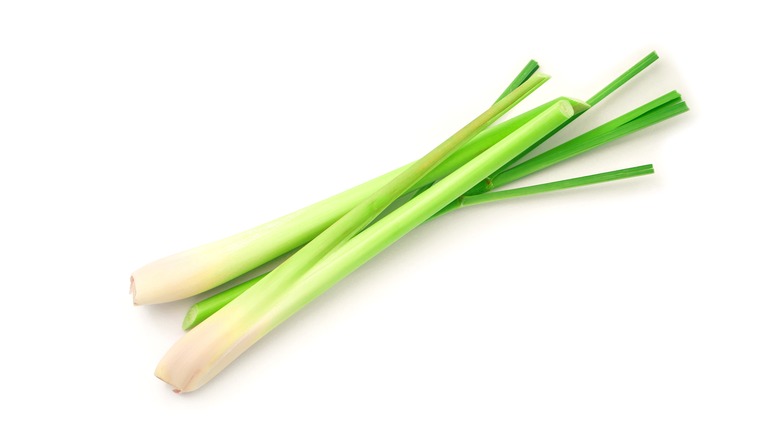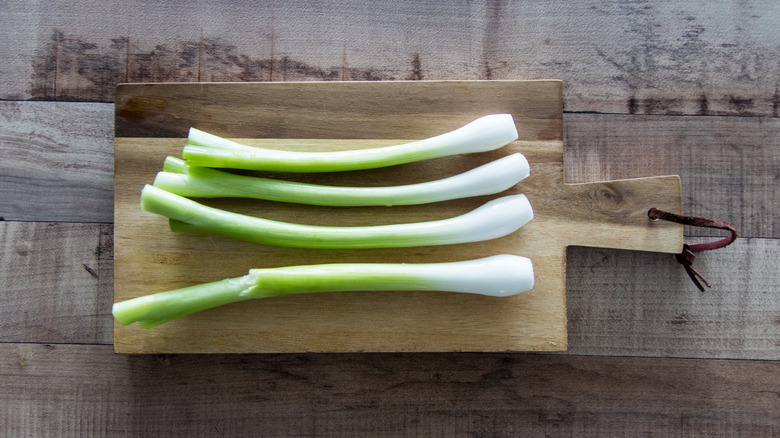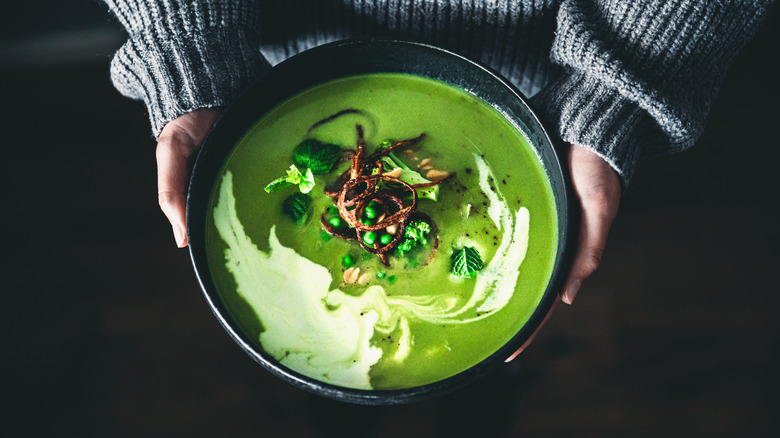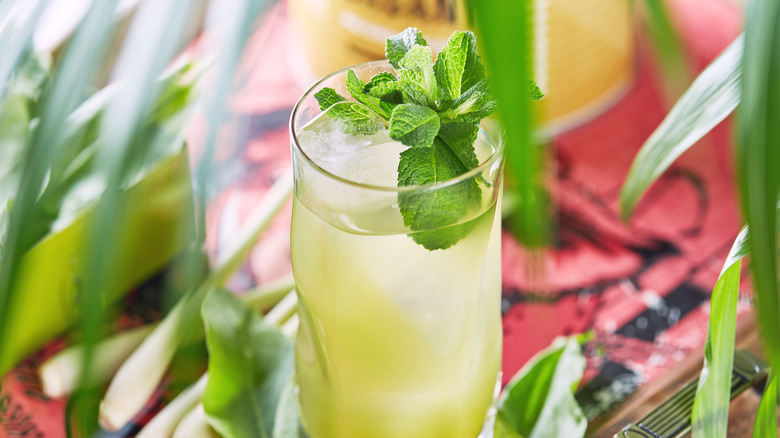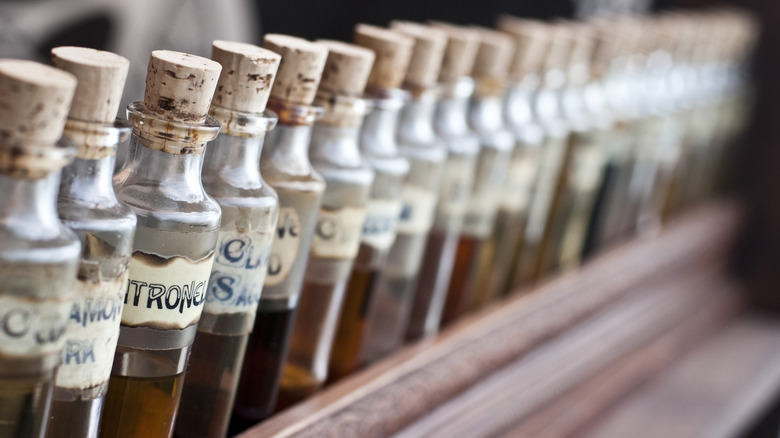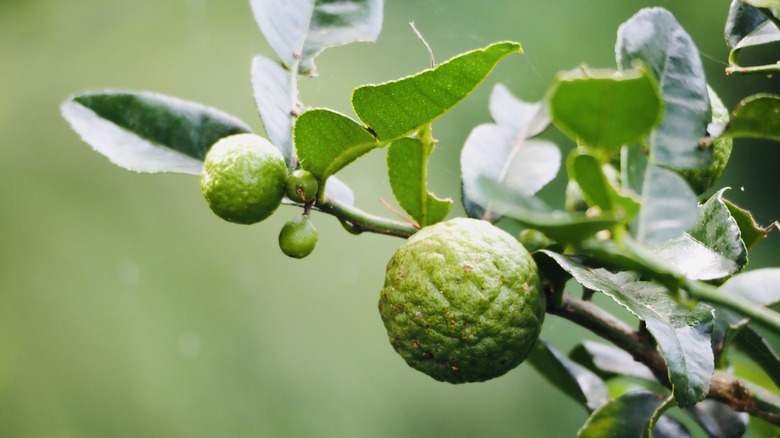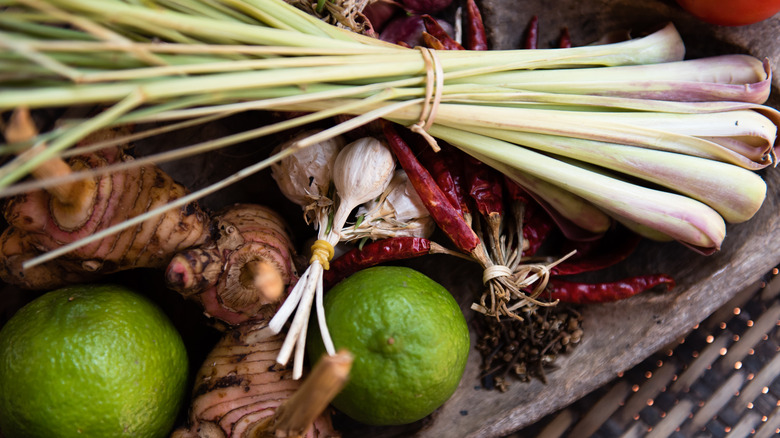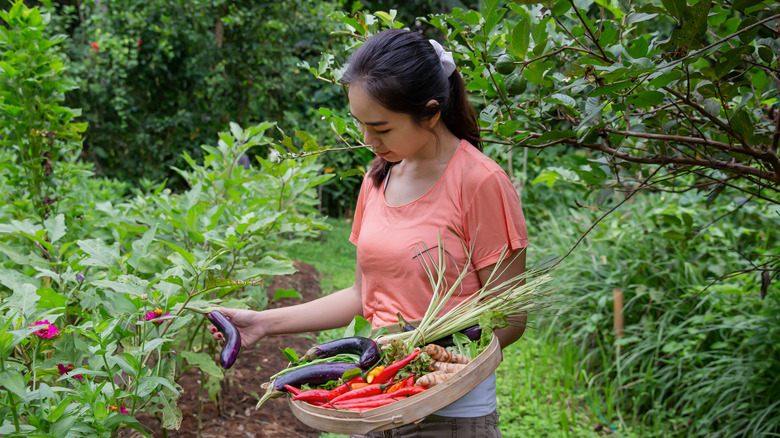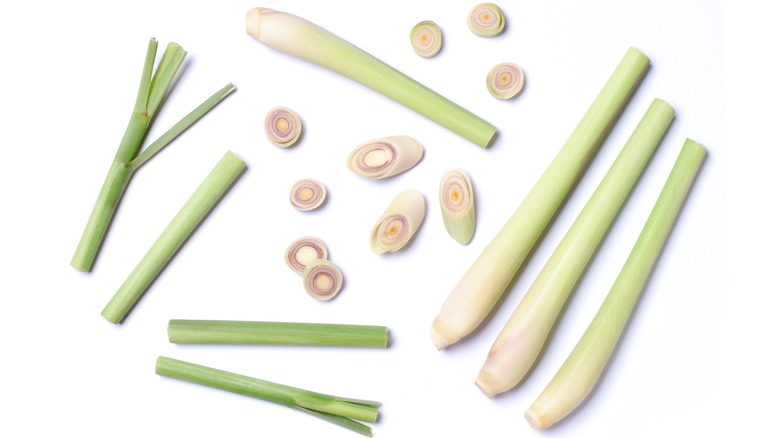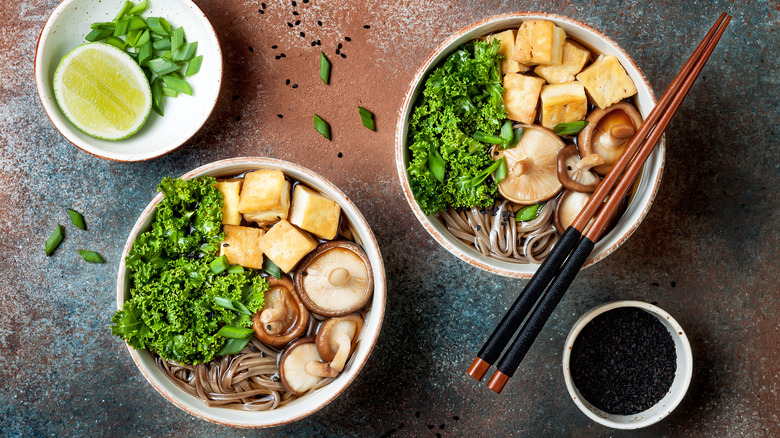The Complete Guide To Cooking With Lemongrass
Although lemongrass is a common ingredient in cooking Asian dishes, especially those from Southeast Asia, many home cooks in America are unfamiliar with its uses and even its identification. However, it is one of the most distinctive flavors in savory cooking and a critical ingredient in many curries, many soups, stews, and meats. Plus it's just, like, incredibly delicious.
That said, lemongrass can be fussy to cook with, especially if you are unfamiliar with it. It's an odd ingredient that is difficult to choose correctly, cut up, and use the right way. If you cook it the wrong way, it will turn a delectable soup into a weird granulated chore your guests must simply get through. Accordingly, if you're not yet familiar with all that is lemongrass, it's time to take a closer look. By the end of this, you'll know all about this delectable plant, how to choose and prepare it, the dishes to which it is suited, and how to keep it fresh at home. Get ready to expand your culinary repertoire.
What is lemongrass?
Lemongrass (Cymbopogon citratus) is a true grass that grows in the tropics, hailing from the family Poaceae. If you've ever wondered why it smells like those mosquito-repelling candles, that's because it's closely related to citronella (Cymbopogon nardus), which is in the same genus. There is a variant called East Indian lemongrass (Cymbopogon flexuosus) that can also be used for cooking, but it is not as common as C. citratus.
Although it is best known for its culinary properties, it also makes a lovely ornamental grass in gardens, which you can learn more about below. The clump-forming grass grows between 2 and 4 feet tall, with tall, thin leaves that drape back down to the ground, reminiscent of the smaller grasses with which you are familiar from more temperature regions. If crushed, it releases a nice, lemony scent (like a Meyer lemon) that you may enjoy in your garden.
Where does lemongrass come from?
Lemongrass is native to India, Burma, Thailand, Malaysia, and Sri Lanka, where it is used for a number of purposes, the most common and well-known of which is cooking, at least in Western culture. Some species are also native to parts of Australia, such as Cymbopogon ambiguus, and it grows well in Africa and the Caribbean, too. Malaysia is generally considered to be its official birthplace. In general, the plant grows within roughly 30 degrees north or south of the equator.
This lemony ingredient is an important crop in many regions of India, although interestingly, it is not typically used as a culinary herb there. Instead, it is usually used in perfumes and as a medicinal herb. It is also used as a scent ingredient in commercial applications, such as soaps, detergents, cosmetics, and even insect repellants, like its cousin citronella. In Southeast Asia, though, it is widely used in the preparation of many types of dishes, prized for its truly inimitable flavor.
Lemongrass flavor
As the name suggests, lemongrass has a distinct lemony scent when it is crushed or chopped. It has a definite lemon tinge to its taste as well, but if you were to eat them side by side and plain, there would be no way of confusing the two.
For one thing, lemon is much more sour. For another, lemongrass has a herby, minty, and almost grassy flavor profile that cooks into something smooth, mild, and sharp all at once, all without the risk of bitterness that the pith in lemon can sometimes carry. In fact, lemongrass is often described as floral and even slightly sweet. For that reason, it's perfect for dishes that call for tang, such as soups and curries, without overpowering or potentially tainting them.
Dried lemongrass, while not as tasty as the fresh stuff, also has an interesting zingy, woodsy flavor. Although it has a nice taste in any form, you cannot (or at least should not) eat lemongrass without cooking it. It is too woody, and unless the thought of chewing cud like a cow all day appeals to you, you must cook lemongrass in order to benefit from its flavor profile.
Where to find lemongrass at stores
Lemongrass is relatively easy to get your hands on. Most larger grocery stores will carry it. Just look for the greenish-white stalks, which can also have a yellow tinge, in the produce department. They are usually located next to the other herbs, or sometimes in the section dedicated to Asian cooking.
If you can't find it at your local grocery store, go to an Asian foods store or an import store. As it is also used in African and Caribbean cooking, you can look for it at stores that cater to such cuisines as well. You can also try dried lemongrass, which brings a flavor all its own. You may also find it in the freezer section. If you have trouble finding lemongrass in your area, then you might want to buy it in bulk when you do find it. If so, you should learn to freeze it to keep it fresh, as it won't last for more than a week and a half in the fridge.
How to choose the best lemongrass
Choosing lemongrass is relatively simple for anyone accustomed to picking produce. Look for fresh, firm, moist, and fleshy-looking stalks. Avoid lemongrass that looks bruised or squishy, as this can affect the flavor.
If the papery leaves on the outside look dry, peel them back to see if the stalk inside looks brighter and fresher. Brown and dried-out leaves are a bad sign, and you should skip that stalk. Typically a well-stocked produce department will have a decent selection, but if you can't find good-looking lemongrass in the produce section, you're better off using the dried powder or slices you'll find in the herb aisle.
When looking for dried lemongrass, check the expiration date. Although dried herbs can last indefinitely without becoming hazardous to your health, they lose their flavor after three years, tops. If you see fading color, that's a sign that dried lemongrass is going south and you might want to use it up.
How to prepare lemongrass
To avoid preparing lemongrass wrong, cut off the bulb at the bottom of the stalk. Now trim off several inches of the tough green leaves at the top of the stalk, so that you're left with the whitish-green fleshy part. You should have about 6 inches of stalk at this point. Peel off the dry outer leaves, leaving only the fresh stalk within, then wash it if necessary.
If the stalk seems particularly dirty, you can treat it like a leek, slicing it in half and then washing both halves before cutting. If you're going to cook it right into a dish or make a paste, cut it up small. If you're infusing the flavor into a dish, feel free to leave the stalk whole and fish it out when you finish cooking; à la bay leaves.
Here's another secret to using lemongrass: Don't throw away the tough tops and bottoms. You can put them in broth and soup, and they'll impart flavor as well. Just make sure to remove them before eating.
The best uses for lemongrass in cooking
Lemongrass is fabulous in soup, curry, and rice, especially from Southeast Asian or Pacific Islander cuisines. It works well as a complement to vegetables, meat, seafood, mushrooms, and even tomato-based dishes. You'll often see it in Thai, Indian, Malaysian, and Sri Lankan foods, which makes sense since these are their native regions. However, you don't have to confine yourself to Asian dishes when cooking with lemongrass.
Like to experiment? You can also start sticking it into your other dishes, such as grilled chicken thighs, tomato bisque recipes, lamb chops, tofu, or generally as a universal marinade. It is extremely versatile because it adds a pleasant but not overpowering tang that is at home in most cuisines. Therefore, using it with smoky, meaty dishes will work regardless of the rest of the flavor palette. That's not all, though. Lemongrass, truly a standup guy when it comes to the kitchen, also works in sweets and drinks.
Lemongrass in baking
Did you know you can bake with lemongrass? Yup, and it's pretty fun. Like how your chocolate chip cookies are missing orange zest, your shortbread cookies could use some lemongrass. Snowball cookies and ginger cookies also work well with it. Lemongrass cake? Yes. Ice cream? Uh-huh. Basically, if you like the flavor of lemongrass and you could make the recipe with lemon, then you can add in the grass factor for a unique update at your next Southeast Asian-inspired dinner party.
You can put lemongrass in almost any recipe for a bright flavor update, like deepening that of a vanilla cake or a lemon pie by infusing in a little of that tangy, floral flavor. Many recipes call for lemongrass paste, while others call for milk infused with lemongrass. A secret to easy baking is to use powdered lemongrass, yet another form in which you can buy it. However, unless you're at an Asian food store, you will probably have to look for the latter online.
Cocktail hour? You bet your sweet grass
The strong, inimitable flavor of lemongrass makes for a fun addition to drinks as well. Whether you're more a fan of the mocktail or of a good old-fashioned drink, lemongrass is a great twist on lemon in gin and tonic or the classic whiskey sour. You can also infuse it into vodka to drink plain as a novelty or use in cocktails. All you have to do is cut lemongrass into 1-inch pieces and cover it with vodka for one to two weeks. Use four stalks of lemongrass for every 2 cups of vodka.
Prefer the virgin variety of drinks? Feel free to look up your favorite cocktails and add some lemongrass for a tangy twist. You can also just steep lemongrass leaves for a tangy, delicious, and healthy tea served hot or cold. Try adding a lemongrass simple syrup to your lemonade or iced tea for a lovely tang that complements citrus well.
If you're not a drinker and therefore can't infuse lemongrass in booze, try a simple syrup instead. Simply combine ¼ cup chunked lemongrass with ½ cup water and ½ cup sugar in a small saucepan. Cook until the sugar dissolves, simmer for about five minutes, and remove from the stove to cool without removing the lemongrass. This will help it continue to infuse. Before you add the syrup to drinks, strain it well to remove the tough, woody pieces, then put it in the fridge to chill.
Other uses for lemongrass
The strong flavor and aroma of lemongrass have made it popular for use in cuisines from hot countries, where food can spoil quickly and bright flavors can help mask strong smells. Although most people who have access to refrigeration don't have to worry about covering up slight spoilage, lemongrass is a great way to disguise more off-putting flavor profiles, such as tempeh.
Moreover, if you like the sweet and floral flavor of lemongrass, you can use it in desserts other than baked goods. For instance, you can put it in pudding or panna cotta. It is particularly delicious paired with passion fruit.
It also has preservative properties. (The same is true of spices such as ginger and turmeric, often used in cuisines from hot countries as well.) It is perhaps no surprise, then, that in addition to its many uses in cooking, lemongrass is also used as a means of masking body odor. It is also effective for fever, can help fight pain and inflammation, and is popular in Ayurvedic medicine.
Substitutes for lemongrass
The truth is that lemongrass has a very subtle and distinct flavor. It is hard to replicate its unique floral, tangy, minty, lemony notes with any other ingredient. Therefore, your substitutes won't be very believable, but they are certainly better than nothing.
If you don't have lemongrass and you need it for a recipe, you can try a few substitutes. However, the final recipe will be better than if you hadn't subbed in anything at all. Some of the best substitutes include real lemon, lime, cilantro, and Kaffir lime leaves. Basil, mint, coriander, and preserved lemon may also do the trick.
If you're an adventurous cook, you can experiment with which combination of these ingredients works the best, which might be more convincing than any of them alone. Many of these flavors pair well with lemongrass too, such as basil, mint, and real lemon. Playing with a new ingredient is a great way to have fun in the kitchen, by yourself, or with kiddos, and can really amp up your flavor profiles.
What about lemongrass paste?
You can buy lemongrass paste online if you don't care to make it yourself, but it's so easy that there's really no point. To make a paste, you simply prep lemongrass stalks as described above, then chop them up into small pieces that can easily break down in a blender or food processor. Most recipes also call for onions or shallots, garlic, and ginger, among other ingredients (which usually depend on the region or country from which the recipe hails).
If you think you're going to use lemongrass regularly in soups, stews, curries, and rice, then it's well worth making it yourself, then storing it in the fridge or freezing in ice cube trays for later use. You can then pop out an ice cube at a time and drop it into your dish when you need it. Just make sure to store the cubes in a plastic bag as soon as they're frozen, or they will take on that funky freezer taste.
How to grow lemongrass
If you're the kind of cook who likes to bring herbs in from the garden, then there's good news: You can grow lemongrass yourself. If you live in USDA Zones 10 or 11, you can grow it as a perennial outside, where it's a nice ornamental plant as well as a culinary ingredient. If you live in Zones 8b and above, you may have luck with the roots overwintering and the plant coming back in the spring. If you're not sure what USDA zone you live in, you can enter your zip code into the USDA Zone map to find out.
If you don't live in a suitable USDA zone, you can grow it as an annual or as a houseplant indoors. Growing as an annual means you plant it in spring and expect it to die in fall. You can find lemongrass at some nurseries or buy seeds online, but fans of the low road can also just buy a stalk at the grocery store and root it in a glass of water.
Keeping lemongrass fresh at home
Unlike fish or meat, you don't need to worry too much about lemongrass going off and becoming dangerous. Of course, if it becomes slimy or smelly, throw it out. Note that these signs aren't very common with food that will actually make you sick. You are in more danger, therefore, if you cook a curry with lemongrass and then leave it on the stove for several hours than you are from eating lemongrass that smells funny. Still, best to be safe.
The bigger concern for lemongrass is that it will dry out and lose its flavor. To prevent this, immediately trim the lemongrass you bring home from the store, even if you're not going to use it right away. Then wrap the tender core in a damp towel and put it in a Ziplock bag. This will stay fresh in the fridge for seven to 10 days.
You can also freeze whole, prepped stalks. Place them on a cookie sheet, ensuring they do not touch one another, as you would do with bananas for smoothies. Once they're frozen, you can put them in a container for up to 12 months.
Nutritional information
Lemongrass is not a calorie-dense food. Indeed, it's extremely light, weighing in at about 5 calories per tablespoon, according to the U.S. Department of Agriculture. Because it contributes so little energy but packs a big flavor punch, it is best classified as an herb. It contains very little protein and fat but does offer some calcium, magnesium, phosphorous, and potassium (the latter at nearly 35 milligrams per serving).
The real health benefits of lemongrass come from its curative properties. If you want to get more of it into your diet, the easiest way to do so is to steep it in hot water to make tea, but you can also cook it into your foods. Although many people worry that buying premade foods in jars depletes their nutritional value, this isn't actually true. If you are a busy worker or parent, go ahead and buy the jarred stuff... your body will thank you.
